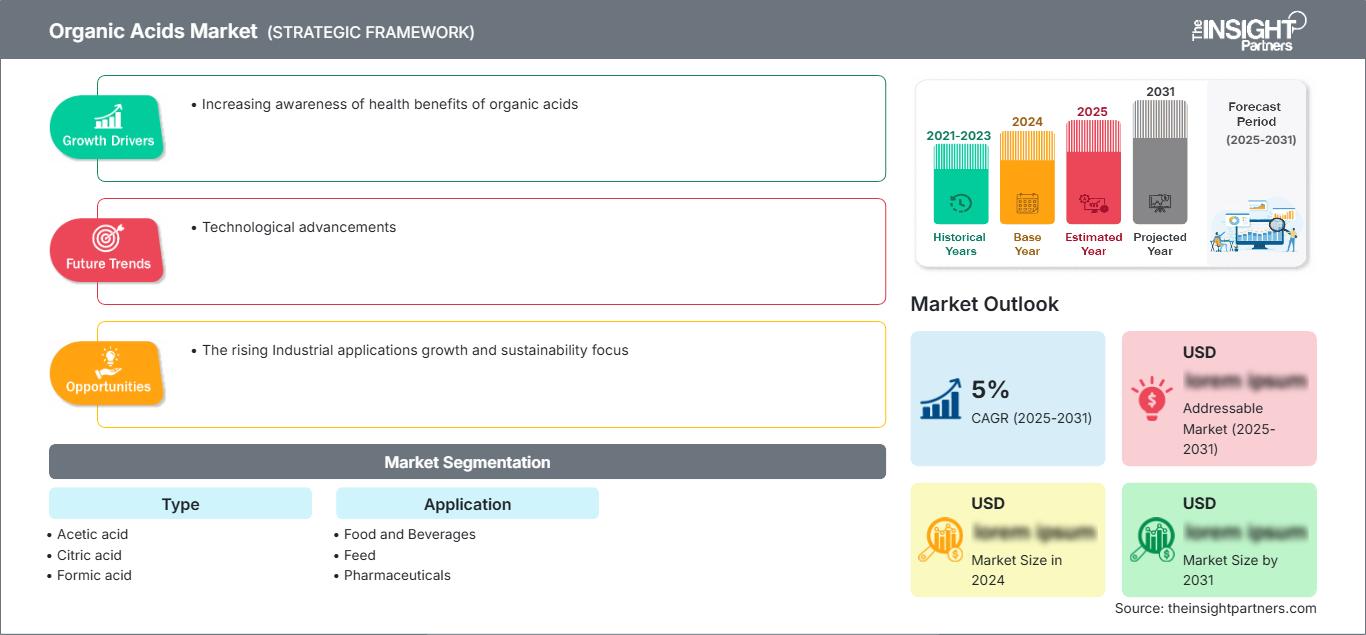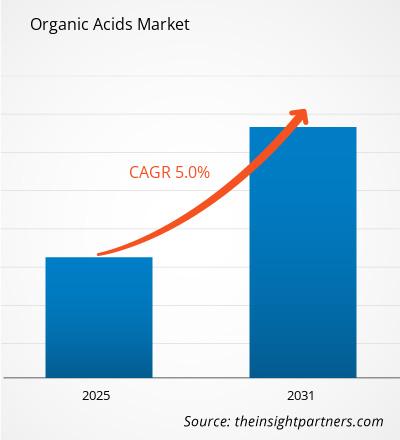Der Markt für organische Säuren wird zwischen 2023 und 2031 voraussichtlich eine durchschnittliche jährliche Wachstumsrate (CAGR) von 5 % verzeichnen. Das zunehmende Wachstum industrieller Anwendungen und der Fokus auf Nachhaltigkeit werden voraussichtlich weiterhin ein wichtiger Trend auf dem Markt bleiben.
Marktanalyse für organische Säuren
- In Branchen wie der Lebensmittel- und Getränkeindustrie, der Textilindustrie und der Pharmaindustrie finden diese Säuren vielfältige Anwendungsmöglichkeiten.
- Das Wachstum des Marktes für organische Säuren wird durch verschiedene Eigenschaften wie Nachhaltigkeit, Biokompatibilität und Umweltfreundlichkeit vorangetrieben.
- Die Expansion in neue Märkte und der Zugang zu internationalen Verbrauchern eröffnen dem Markt für organische Säuren vielfältige Möglichkeiten.
- Organische Säuren erhalten die Zellintegrität der Darmschleimhaut und verbessern die Verdauung durch die Erhaltung einer normalen Darmflora.
- Die Aufnahme von Proteinen, Aminosäuren und Mineralstoffen kann durch die Zugabe organischer Säuren zur Ernährung verbessert werden.
- Der Markt für organische Säuren bietet erhebliche Wachstumschancen durch das gestiegene Verbraucherbewusstsein für die vielfältigen gesundheitlichen Vorteile organischer Säuren.
Marktübersicht für organische Säuren
- Der Haupttreiber für die Verwendung organischer Säuren in Futtermitteln ist die steigende Nachfrage nach antibiotikafreien tierischen Nebenprodukten, angetrieben durch die wachsende Der weltweite Verbrauch von Lebensmitteln tierischen Ursprungs wird voraussichtlich in Zukunft weiter steigen.
- Spuren von Antibiotika in tierischen Nebenprodukten und deren negative Auswirkungen auf die menschliche Gesundheit sind alarmierende Gründe, den Einsatz von Antibiotika in Tierfutter zu beenden.
- Diese könnten durch organische Futtersäure ersetzt werden, die dieselben Vorteile bietet und mit ihren antimikrobiellen Eigenschaften zudem verhindert, dass das Getreide während der Lagerung beschädigt wird, was die Haltbarkeit des Futters erhöht und die Nachfrage nach organischer Futtersäure antreibt.
Passen Sie diesen Bericht Ihren Anforderungen an
Sie erhalten kostenlos Anpassungen an jedem Bericht, einschließlich Teilen dieses Berichts oder einer Analyse auf Länderebene, eines Excel-Datenpakets sowie tolle Angebote und Rabatte für Start-ups und Universitäten.
Markt für organische Säuren: Strategische Einblicke

-
Holen Sie sich die wichtigsten Markttrends aus diesem Bericht.Dieses KOSTENLOSE Beispiel umfasst Datenanalysen, die von Markttrends bis hin zu Schätzungen und Prognosen reichen.
Markttreiber und -chancen für organische Säuren
Das zunehmende Bewusstsein für die gesundheitlichen Vorteile organischer Säuren dürfte das Wachstum des Marktes für organische Säuren vorantreiben.
- Der Markt für organische Säuren steht vor einem Wachstum, das größtenteils durch das zunehmende Bewusstsein der Verbraucher für ihre gesundheitlichen Vorteile getrieben wird.
- Diese Verbindungen, darunter Zitronensäure, Essigsäure und Milchsäure, gewinnen aufgrund ihres Nährwerts, ihrer potenziellen Verbesserung der Darmgesundheit und ihrer natürlichen antimikrobiellen Eigenschaften an Anerkennung.
- Da Verbraucher zunehmend gesundheitsbewusst sind, werden organische Säuren zunehmend in funktionelle Lebensmittel, Getränke und Nahrungsergänzungsmittel integriert. Dies entspricht dem Clean-Label-Trend und der Nachfrage nach natürlichen Konservierungsmethoden.
- Einige organische Säuren werden zudem auf ihre potenzielle Rolle bei der Gewichtskontrolle und dem Stoffwechsel untersucht, was ihre Attraktivität weiter steigert.
- Dieses wachsende Bewusstsein wird durch laufende Forschung und Verbraucheraufklärung unterstützt, was zu einer stärkeren regulatorischen Unterstützung von gesundheitsbezogenen Angaben führen könnte.
Technologische Fortschritte
- Innovationen in den Produktionsmethoden werden den Markt für organische Säuren revolutionieren und versprechen kostengünstigere und effizientere Herstellungsprozesse.
- Diese Fortschritte sollen die Produktionskosten senken, die Erträge steigern und die Nachhaltigkeit durch Minimierung von Energieverbrauch und Abfall verbessern.
- Biotechnologische Durchbrüche ermöglichen die Produktion organischer Säuren aus erneuerbaren Ressourcen und verringern so die Abhängigkeit von petrochemischen Rohstoffen.
- Verbesserte Skalierbarkeit und verbesserte Produktqualität sind weitere Vorteile dieser innovativen Methoden.
Segmentierungsanalyse des Marktberichts zu organischen Säuren
Schlüsselsegmente, die zur Ableitung der Marktanalyse für organische Säuren beigetragen haben, sind Typ und Anwendung.
- Basierend auf dem Typ ist der Markt für organische Säuren in Essigsäure, Zitronensäure, Ameisensäure, Milchsäure, Propionsäure, Ascorbinsäure, Gluconsäure, Fumarsäure, Äpfelsäure und andere segmentiert.
- Basierend auf der Anwendung ist der Markt für organische Säuren in Lebensmittel und Getränke, Futtermittel, Pharmazeutika und Industrie unterteilt.
Marktanteilsanalyse für organische Säuren nach Geografie
- Der Marktbericht für organische Säuren umfasst eine detaillierte Analyse von fünf großen geografischen Regionen, einschließlich der aktuellen und historischen Marktgröße und Prognosen für 2021 bis 2031, und deckt Nordamerika, Europa, den asiatisch-pazifischen Raum (APAC), den Nahen Osten und Afrika (MEA) sowie Süd- und Mittelamerika ab.
- Jede Region ist weiter in die jeweiligen Länder unterteilt. Dieser Bericht bietet Analysen und Prognosen für über 18 Länder und deckt die Marktdynamik für organische Säuren ab, wie etwa Treiber, Trends und Chancen, die die Märkte auf regionaler Ebene beeinflussen.
- Darüber hinaus umfasst der Bericht Porters Fünf-Kräfte-Analyse, die die Untersuchung der wichtigsten Faktoren umfasst, die den Markt für organische Säuren in diesen Regionen beeinflussen.
Organische Säuren
Regionale Einblicke in den Markt für organische SäurenDie Analysten von The Insight Partners haben die regionalen Trends und Faktoren, die den Markt für organische Säuren im Prognosezeitraum beeinflussen, ausführlich erläutert. In diesem Abschnitt werden auch die Marktsegmente und die geografische Lage für organische Säuren in Nordamerika, Europa, dem asiatisch-pazifischen Raum, dem Nahen Osten und Afrika sowie Süd- und Mittelamerika erörtert.
Umfang des Marktberichts über organische Säuren
| Berichtsattribut | Einzelheiten |
|---|---|
| Marktgröße in 2024 | US$ XX million |
| Marktgröße nach 2031 | US$ XX Million |
| Globale CAGR (2025 - 2031) | 5% |
| Historische Daten | 2021-2023 |
| Prognosezeitraum | 2025-2031 |
| Abgedeckte Segmente |
By Typ
|
| Abgedeckte Regionen und Länder |
Nordamerika
|
| Marktführer und wichtige Unternehmensprofile |
|
Dichte der Marktteilnehmer für organische Säuren: Verständnis ihrer Auswirkungen auf die Geschäftsdynamik
Der Markt für organische Säuren wächst rasant. Die steigende Nachfrage der Endverbraucher ist auf Faktoren wie veränderte Verbraucherpräferenzen, technologische Fortschritte und ein stärkeres Bewusstsein für die Produktvorteile zurückzuführen. Mit der steigenden Nachfrage erweitern Unternehmen ihr Angebot, entwickeln Innovationen, um den Bedürfnissen der Verbraucher gerecht zu werden, und nutzen neue Trends, was das Marktwachstum weiter ankurbelt.

- Holen Sie sich die Markt für organische Säuren Übersicht der wichtigsten Akteure
Marktneuigkeiten und aktuelle Entwicklungen im Bereich organische Säuren
Der Markt für organische Säuren wird durch die Erhebung qualitativer und quantitativer Daten aus Primär- und Sekundärforschung bewertet, die wichtige Unternehmenspublikationen, Verbandsdaten und Datenbanken umfasst. Einige der Entwicklungen auf dem Markt für organische Säuren sind unten aufgeführt:
- Addcon gibt die erfolgreiche Einführung von drei organischen Säureprodukten in Indonesien durch seinen geschätzten Vertriebspartner Novindo bekannt. (Quelle: Newsletter, Addcon, Februar 2024)
- Solugen und ADM geben strategische Partnerschaft bekannt, um die steigende Nachfrage nach nachhaltigen Produkten mit einer neuen Bioproduktionsanlage im Mittleren Westen der USA zu decken. (Quelle: Newsletter, Solugen, Okt. 2023)
Bericht zum Markt für organische Säuren: Umfang und Ergebnisse
Der „Markt für organische Säuren: Größe und Prognose (2021–2031)“ Der Bericht bietet eine detaillierte Analyse des Marktes und deckt die folgenden Bereiche ab:
- Marktgröße und Prognose für organische Säuren auf globaler, regionaler und Länderebene für alle wichtigen Marktsegmente, die in den Geltungsbereich fallen
- Markttrends und Marktdynamiken für organische Säuren wie Treiber, Einschränkungen und wichtige Chancen
- Detaillierte PEST/Porters Five Forces- und SWOT-Analyse
- Marktanalyse für organische Säuren mit wichtigen Markttrends, globalen und regionalen Rahmenbedingungen, wichtigen Akteuren, Vorschriften und aktuellen Marktentwicklungen
- Branchenlandschaft und Wettbewerbsanalyse mit Marktkonzentration, Heatmap-Analyse, prominenten Akteuren und aktuellen Entwicklungen für den Markt für organische Säuren
- Detaillierte Unternehmensprofile
- Historische Analyse (2 Jahre), Basisjahr, Prognose (7 Jahre) mit CAGR
- PEST- und SWOT-Analyse
- Marktgröße Wert/Volumen – Global, Regional, Land
- Branchen- und Wettbewerbslandschaft
- Excel-Datensatz
Aktuelle Berichte
Verwandte Berichte
Erfahrungsberichte
Grund zum Kauf
- Fundierte Entscheidungsfindung
- Marktdynamik verstehen
- Wettbewerbsanalyse
- Kundeneinblicke
- Marktprognosen
- Risikominimierung
- Strategische Planung
- Investitionsbegründung
- Identifizierung neuer Märkte
- Verbesserung von Marketingstrategien
- Steigerung der Betriebseffizienz
- Anpassung an regulatorische Trends






















 Kostenlose Probe anfordern für - Markt für organische Säuren
Kostenlose Probe anfordern für - Markt für organische Säuren